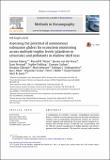Assessing the potential of autonomous submarine gliders for ecosystem monitoring across multiple trophic levels (plankton to cetaceans) and pollutants in shallow shelf seas
Date
09/2014Author
Grant ID
NE/J020176/1
PCIG10-GA-2011-304132
Keywords
Metadata
Show full item recordAbstract
A combination of scientific, economic, technological and policy drivers is behind a recent upsurge in the use of marine autonomous systems (and accompanying miniaturized sensors) for environmental mapping and monitoring. Increased spatial-temporal resolution and coverage of data, at reduced cost, is particularly vital for effective spatial management of highly dynamic and heterogeneous shelf environments. This proof-of-concept study involves integration of a novel combination of sensors onto buoyancy-driven submarine gliders, in order to assess their suitability for ecosystem monitoring in shelf waters at a variety of trophic levels. Two shallow-water Slocum gliders were equipped with CTD and fluorometer to measure physical properties and chlorophyll, respectively. One glider was also equipped with a single-frequency echosounder to collect information on zooplankton and fish distribution. The other glider carried a Passive Acoustic Monitoring system to detect and record cetacean vocalizations, and a passive sampler to detect chemical contaminants in the water column. The two gliders were deployed together off southwest UK in autumn 2013, and targeted a known tidal-mixing front west of the Isles of Scilly. The gliders' mission took about 40 days, with each glider travelling distances of >1000km and undertaking >2500 dives to depths of up to 100m. Controlling glider flight and alignment of the two glider trajectories proved to be particularly challenging due to strong tidal flows. However, the gliders continued to collect data in poor weather when an accompanying research vessel was unable to operate. In addition, all glider sensors generated useful data, with particularly interesting initial results relating to subsurface chlorophyll maxima and numerous fish/cetacean detections within the water column. The broader implications of this study for marine ecosystem monitoring with submarine gliders are discussed.
Citation
Suberg , L , Wynn , R B , Kooij , J V D , Fernand , L , Fielding , S , Guihen , D , Gillespie , D , Johnson , M , Gkikopoulou , K C , Allan , I J , Vrana , B , Miller , P I , Smeed , D & Jones , A R 2014 , ' Assessing the potential of autonomous submarine gliders for ecosystem monitoring across multiple trophic levels (plankton to cetaceans) and pollutants in shallow shelf seas ' , Methods in Oceanography , vol. 10 , pp. 70-89 . https://doi.org/10.1016/j.mio.2014.06.002
Publication
Methods in Oceanography
Status
Peer reviewed
ISSN
2211-1220Type
Journal article
Description
The Gliders and AUVs for Marine Observation and Research (GLAMOR) project was primarily funded by UK Department for the Environment, Food and Rural Affairs (Defra), through their Strategic Evidence and Partnerships Fund. Damien Guihen was funded by Natural Environment Research Council (NERC) grant NE/H014756/1. Additional financial support came through Defra project MF1112 (POSEIDON). Ian Allan (NIVA) and Branislav Vrana (RECETOX) acknowledge funding from the European Union Seventh Framework Programme (FP7/2007–2013) under grant agreement no. 262584, JERICO (TNA project GLISS).Collections
Items in the St Andrews Research Repository are protected by copyright, with all rights reserved, unless otherwise indicated.

